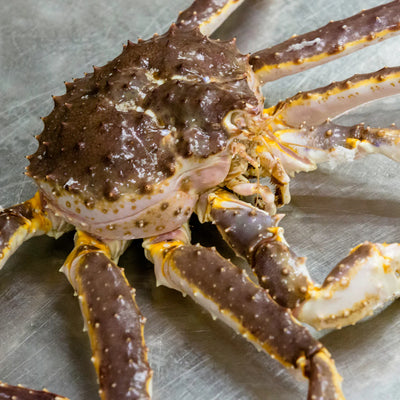+Shop Now
+Categories
- Abalone
- Ahi Tuna
- Alaskan King Crab Legs
- Alaskan Pollock
- Alaskan Sockeye Salmon
- Albacore Tuna
- Anchovy
- Anxiety Relief
- appetizer
- Atlantic Salmon
- Beluga Caviar
- Best Sushi
- black caviar
- black cod
- Blue crabs
- Bluefin Tuna
- Brain Function
- Branzino
- breakfast
- Calamari
- caviar
- Caviar Recipes
- Chef Knives
- Chilean Sea Bass
- Clams
- cocktail caviar
- Cod
- Coho Salmon Caviar
- collagen
- Cooking Methods
- crab
- Crab Balls
- Crab Cakes
- Crab claws
- crab meat
- Crab Recipes
- culinary tips
- decline-sturgeon
- Diver Scallops
- Dover Sole
- Dry Aged Fish
- Dungeness Crab
- Dungeness crab clusters
- Dungeness Crab Legs
- Exotic Shellfish Sampler
- Fish and Seafood
- fish oil
- Fish Sauce
- flat fish
- FLOUNDER FISH
- Focus
- Fresh Seafood Delivery
- Fresh Wild Alaskan Salmon
- Geoduck
- Gooseneck Barnacles
- Gourmet Seafood Platter
- haddock
- halibut
- Halibut Recipes
- hamachi
- Hamachi Recipe
- health
- healthy eating
- Ikura
- Japanese restaurants
- Jonah crab
- Jumbo Sea Scallops
- Kaluga Caviar
- kelp
- king crab
- King Crab Legs
- King Salmon
- kitchen
- Lingcod
- Live King Crab
- Live Lobsters for Sale
- Live Scallops
- Live seafood
- lobster
- Lobster Tail
- luxury food
- mahi mahi
- Marine Collagen
- Mollusk
- Monkfish
- Mussels
- New
- Nutrition
- octopus
- Opah
- Ora King Salmon
- Osetra Caviar
- Ossetra Sturgeon Caviar
- oysters
- Pacific Cod
- Pacific Hake
- Pacific Halibut
- Pacific Ocean
- Pacific Whiting
- Pacific Whiting Recipe
- Paddlefish Caviar
- Petite Oysters
- Petrale Sole
- Poke Tuna
- Pollock
- Pregnancy
- Premium Caviar Selection
- Recipe
- red caviar
- Red Crab
- rock fish
- Rockfish
- Rockfish Recipes
- sablefish
- Sablefish (Black Cod) Recipes
- salmon
- Salmon Caviar
- Salmon lox
- Salmon Poke
- Salmon Recipes
- salmon roe
- Sardines
- Sashimi
- Sashimi-Grade Tuna
- Scallop
- scallops
- Scallops Recipe
- Sea Urchi Recipe
- sea urchin
- Sea Urchin Sushi
- sea weed
- Seafood
- Seafood Dishes
- Seafood Market
- Seafood Recipe
- Seafood Restaurants
- sevruga caviar
- shellfish
- Shrimps & Prawns
- Silver Salmon
- Smoked
- Smoked Salmon
- Smoked Tuna
- Snail Caviar
- Snapper Recipe
- snow crab
- Sole & Flounder Recipes
- Squid
- Steelhead
- Sturgeon Caviar
- Sustainable Seafood Choices
- Swordfish
- Tilapia
- Tilapia Fish
- Tobiko
- Trout
- tuna
- Tuna Recipe
- weathervane scallops
- white fish
- White Sturgeon
- White Sturgeon Caviar
- Whiting Fish
- Wild Caught Shrimp
- Yellowfin Tuna
- Yellowtail snapper
The Anatomy of Live King Crab: Understanding the Parts
June 07, 2023

The Anatomy of Live King Crab: Understanding the Parts
When it comes to seafood delicacies, few can rival the taste and elegance of live king crab. From its enormous claws to its delicate legs, understanding the anatomy of these crustaceans can deepen your appreciation for their culinary value. In this article, we'll delve into the various parts of a live king crab and unravel the secrets behind their remarkable structure.
The Body:
The body of a live king crab consists of two main sections: the carapace and the abdomen. The carapace, or shell, serves as a protective armor, safeguarding the crab's internal organs. Meanwhile, the abdomen houses the crab's reproductive organs and provides flexibility for movement.
The Claws:
One of the most iconic features of a live king crab is its large, powerful claws. These formidable appendages are responsible for capturing prey and defending against predators. The bigger claw, known as the crusher claw, is designed for crushing shells and prey, while the smaller claw, called the pincer claw, is more dexterous and used for gripping.
The Legs:
King crabs have a total of ten legs, each serving a specific purpose. The first pair of legs, known as chelipeds, are the largest and feature the crab's claws. The remaining eight legs, called walking legs, are used for mobility and are adorned with sharp spines for protection. These legs play a crucial role in the crab's ability to scuttle along the ocean floor.
The Thorax and Abdomen:
Located between the body and the walking legs, the thorax is composed of segments that allow the king crab to flex and move. The abdomen, on the other hand, contains the crab's reproductive organs and provides space for storing nutrients.
FAQs:
Q1: Can all the parts of a king crab be eaten?
A1: Yes, many parts of a king crab are edible, including the legs, claws, and body meat. Each section offers a distinct texture and flavor.
Q2: What is the best way to cook king crab?
A2: Steaming or boiling are popular methods for cooking king crab. This helps retain the crab's natural flavors and preserves its succulent meat.
Q3: Are there any health benefits to eating king crab?
A3: Yes, king crab is a good source of lean protein and contains essential vitamins and minerals such as zinc and omega-3 fatty acids, which promote heart health.
Conclusion:
Understanding the anatomy of a live king crab sheds light on its extraordinary adaptability and distinct flavor. From the robust claws to the intricate leg structure, each part contributes to the crab's overall survival and culinary appeal. Whether you enjoy king crab as a delicacy or simply appreciate the wonders of marine life, exploring the anatomy of these fascinating crustaceans adds an extra layer of appreciation to your seafood experience.
Remember, the next time you savor the succulent meat of a live king crab, you'll have a deeper understanding of the intricate workings that make this majestic creature a true marvel of nature.
🦀 Buy Alaskan King Crab Online – Fresh, Premium & Delivered to Your Door!
Looking for restaurant-quality Alaskan King Crab? Order online from GlobalSeafoods.com and enjoy wild-caught, premium king crab legs and claws delivered fresh to your home. Perfect for boiling, grilling, or baking, these sweet, succulent crab legs are a true gourmet seafood experience!
🔥 Top King Crab Selections:
✅ Jumbo Alaskan Red King Crab Legs – Large, meaty, and packed with flavor.
✅ Deliciously Fresh King Crab Legs – A luxurious seafood feast!
✅ King Crab Leg Pieces – Perfect for soups, salads, and seafood dishes.
✅ Live King Crab – The ultimate fresh seafood experience.
✅ Golden King Crab – A slightly sweeter, delicate alternative to red king crab.
🚚 Fast, Fresh Shipping | 💯 Sustainably Sourced | 🏆 Wild-Caught & Premium Quality
🛒 Order your Alaskan King Crab today at GlobalSeafoods.com!
Related Products
Share:
Also in News

How to Make Sea Bream Sushi With Dry-Aged Tuna & Crab Roll — Step-by-Step With Chef Joshua
December 07, 2025
A complete guide to making Sea Bream sushi at home, including filleting, curing, slicing, and building a Dry-Aged Tuna & Crab sushi roll. Chef Joshua shares professional tips for restaurant-quality results.

Boiled Crab for Game Night: Everything You Need for a Perfect Seafood Party
June 27, 2025
Take your game night to the next level with a Boiled crab party. Learn the best recipes, cooking tips, and hosting hacks for a memorable seafood feast.

Boiled Crab for Date Night: A Romantic Guide to the Perfect Seafood Feast
June 27, 2025
Make your next date night unforgettable with a romantic Boiled crab experience. This guide covers everything you need to know, from ambiance to the best crab varieties.
+Shop Now
+Categories
- Abalone
- Ahi Tuna
- Alaskan King Crab Legs
- Alaskan Pollock
- Alaskan Sockeye Salmon
- Albacore Tuna
- Anchovy
- Anxiety Relief
- appetizer
- Atlantic Salmon
- Beluga Caviar
- Best Sushi
- black caviar
- black cod
- Blue crabs
- Bluefin Tuna
- Brain Function
- Branzino
- breakfast
- Calamari
- caviar
- Caviar Recipes
- Chef Knives
- Chilean Sea Bass
- Clams
- cocktail caviar
- Cod
- Coho Salmon Caviar
- collagen
- Cooking Methods
- crab
- Crab Balls
- Crab Cakes
- Crab claws
- crab meat
- Crab Recipes
- culinary tips
- decline-sturgeon
- Diver Scallops
- Dover Sole
- Dry Aged Fish
- Dungeness Crab
- Dungeness crab clusters
- Dungeness Crab Legs
- Exotic Shellfish Sampler
- Fish and Seafood
- fish oil
- Fish Sauce
- flat fish
- FLOUNDER FISH
- Focus
- Fresh Seafood Delivery
- Fresh Wild Alaskan Salmon
- Geoduck
- Gooseneck Barnacles
- Gourmet Seafood Platter
- haddock
- halibut
- Halibut Recipes
- hamachi
- Hamachi Recipe
- health
- healthy eating
- Ikura
- Japanese restaurants
- Jonah crab
- Jumbo Sea Scallops
- Kaluga Caviar
- kelp
- king crab
- King Crab Legs
- King Salmon
- kitchen
- Lingcod
- Live King Crab
- Live Lobsters for Sale
- Live Scallops
- Live seafood
- lobster
- Lobster Tail
- luxury food
- mahi mahi
- Marine Collagen
- Mollusk
- Monkfish
- Mussels
- New
- Nutrition
- octopus
- Opah
- Ora King Salmon
- Osetra Caviar
- Ossetra Sturgeon Caviar
- oysters
- Pacific Cod
- Pacific Hake
- Pacific Halibut
- Pacific Ocean
- Pacific Whiting
- Pacific Whiting Recipe
- Paddlefish Caviar
- Petite Oysters
- Petrale Sole
- Poke Tuna
- Pollock
- Pregnancy
- Premium Caviar Selection
- Recipe
- red caviar
- Red Crab
- rock fish
- Rockfish
- Rockfish Recipes
- sablefish
- Sablefish (Black Cod) Recipes
- salmon
- Salmon Caviar
- Salmon lox
- Salmon Poke
- Salmon Recipes
- salmon roe
- Sardines
- Sashimi
- Sashimi-Grade Tuna
- Scallop
- scallops
- Scallops Recipe
- Sea Urchi Recipe
- sea urchin
- Sea Urchin Sushi
- sea weed
- Seafood
- Seafood Dishes
- Seafood Market
- Seafood Recipe
- Seafood Restaurants
- sevruga caviar
- shellfish
- Shrimps & Prawns
- Silver Salmon
- Smoked
- Smoked Salmon
- Smoked Tuna
- Snail Caviar
- Snapper Recipe
- snow crab
- Sole & Flounder Recipes
- Squid
- Steelhead
- Sturgeon Caviar
- Sustainable Seafood Choices
- Swordfish
- Tilapia
- Tilapia Fish
- Tobiko
- Trout
- tuna
- Tuna Recipe
- weathervane scallops
- white fish
- White Sturgeon
- White Sturgeon Caviar
- Whiting Fish
- Wild Caught Shrimp
- Yellowfin Tuna
- Yellowtail snapper
Shop Now
Main
News & Updates
Sign up to get the latest on sales, new releases and more…
© 2025 Global Seafoods North America.

